Conservation Work
ICI Delhi offers a wide variety of professional conservation and preservation services to various governmental and non-governmental organizations, private collectors and corporate clients. Objects requiring varying levels of study, evaluation as well as treatment can be brought to the Centre. A dedicated team of conservators represent years of varied professional training at major institutions, both in India and abroad, specialized study, and intensive practical experience in the science of conservation and study of objects may be requested. The conservation staff can also facilitate scientific study and analysis of objects.
Services offered at ICI Delhi may vary from simple preventive stabilization methods to complete conservation treatment and restorative reintegration.
The lab is equipped with all the basic conservation tools and equipment as well as material to be used for storage, display and preventive conservation. Large tables, comfortable work chairs, trolleys (to keep tables clear of tools, pens etc.) and good illumination (close to natural light) is available. There is an in-built ducting system for fume extraction for the safety and health of staff. The services and facilties available in the lab are as follows.
Examination, documentation and environmental monitoring for preventive conservation is an essential for all conservation divisions. Facilities available include:
Lux meter – To measure the intensity of light
Whirling hygrometer – To measure relative humidity in museums and art galleries
UV light meter – To measure intensity of Ultra Violet Light
Distance measuring meter – It is used for measuring of distance specially in heritage buildings
Data logger – It is used for monitoring and recording of relative humidity and temperature
Thermal camera – It is used for thermal imaging, determining presence of humidity and moisture in heritage building.
Multi spectrum imaging kit – Used for non-invasive examination of art objects
UV light – Source of UV light for examination
IR light – Source of IR light for examination
IR camera – To identify under drawing and pentimento
Light Sheet – To work on objects with transmitted light
Mount cutting machine – Use for cutting of mounts for matting
Painting conservation division
Conservation treatment of deteriorated or damaged paintings is undertaken. Conservators try to intervene as little as possible so that the artist’s original work is not lost. In this lab, conservators carefully work to secure flaking paint, mend tears and losses, relax bulges in canvas, strengthen canvas supports, settle cracks and remove unstable materials. Some facilities are:
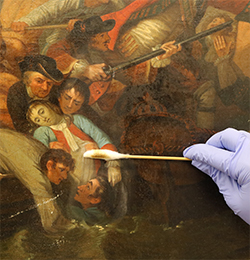
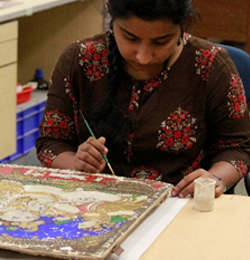
- Low pressure suction table – Flatting, lining and humidification of objects
- Hot spatula – For consolidation of paint layer
- Double boiler – It is used for preparation of consolidants and adhesives
- Air spray gun and machine – Application of protective coating to the art object without touching the surface
- Adjustable stretcher – For lining canvases of different sizes
Paper conservation division
Paper Conservation division conservators examine, document, and treat a wide variety of works on paper. Typical conservation treatments and preventive measures include surface cleaning, removing previous interventions such as pressure-sensitive tape, mending and poor-quality matting materials, reducing discoloration and staining, flattening paper distortions, strengthening of paper supports and housing artworks in acid-free materials. Some facilties are:
- Ultrasonic humidifier – It is used for consolidation and humidification of art objects especially paper and painted paper objects
- Nebulizer – It is used for consolidation and humidification of art objects especially paper and painted paper objects
- Specialized Sink – For undertaking wet treatments
- Light tables – For proper mending and conservation
Objects conservation division
The three-dimensional objects treated in this division are made of a variety of materials and often times a combination of materials. Conservators working here are trained and equipped to handle objects made of stone, wood, metal, bone, ivory, ceramic, leather, plaster, and other synthetic materials. Treatments vary depending on the size, shape, and composition of the object, from the tiniest to heaviest sculptures.
- Micro sand blaster – To remove/clean accretion from architectural surface and art objects
- Steam cleaner – To remove/clean accretion, micro-biological deposition from architectural surface and art objects
- Micro chisels – To remove unscientific fillings from art objects and also from stone buildings
- Carts and pulleys – For transferring and supporting heavy objects
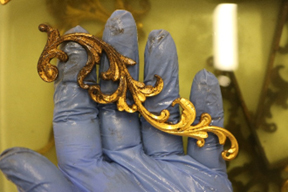
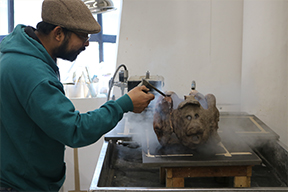
Textile conservation
Every textile that comes to the division for treatment is carefully examined for its conservation needs. The goal of the textile conservator is to provide stabilization and support, and minimize further deterioration. This may include both curative conservation from surface to wet cleaning, stabilization through stitching or adhesive treatments and preventive recommendations, such as supportive storage or environmental guidelines or hanging/mounting options.
- Darning Table – For undertaking stabilization through stitching
- Portable Fume Extractor – For removal of harmful fumes
- Conservation dyeing unit with Lanaset dyes – For conservation grade dyeing
- Steamers – For removing creases delicately
- Storage rack for large rolled textiles – For storing textiles properly
- Microscope – For studying fibres
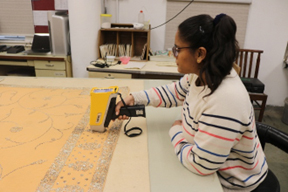
Study of metal threads on a textile using XRF
On-site conservation: The ICI Centres undertake conservation of collections on site by setting temporary laboratories. Projects involving in-situ conservation and preservation of stone and decorative features of monumental architecture that include wall paintings, stucco and plaster finishes, mosaics, tiles, cast stone, terracotta, relief work, decorated wooden elements, decorative glass, gilding and other embellishments are also undertaken.
Consultation: Conservators can also offer advice and solutions to issues related to care and upkeep, storage, proper display, exhibition and safe transportation.
Projects related to conservation and researches are also undertaken in collaboration with other institutions and organizations.









